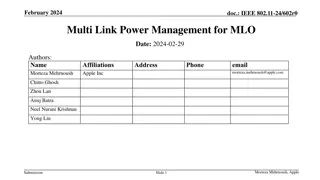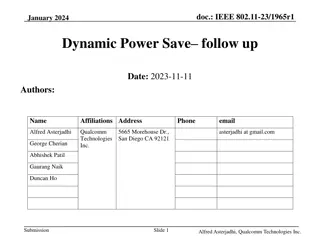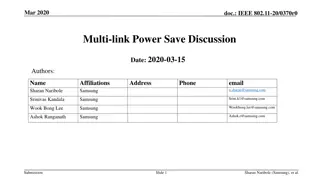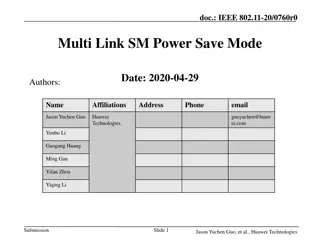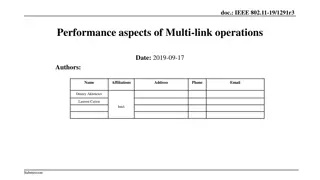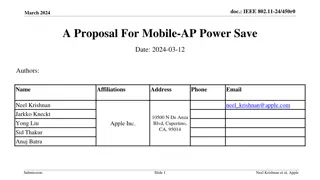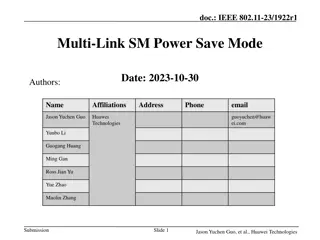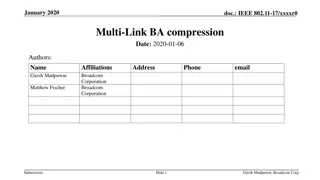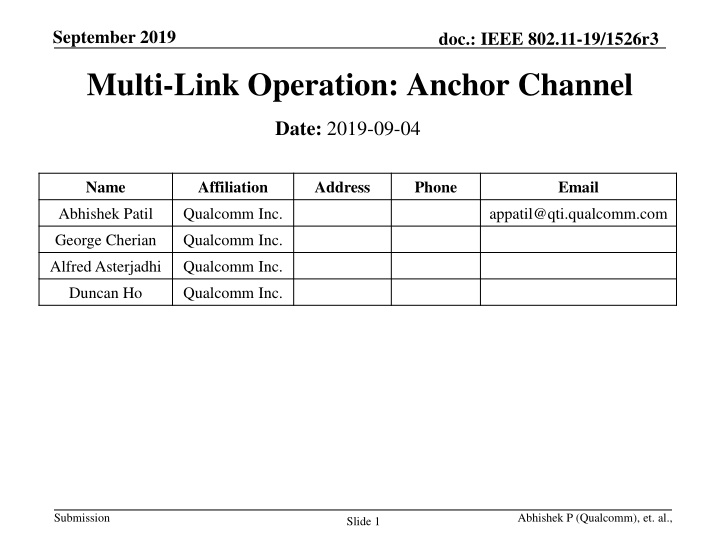
IEEE 802.11-19/1526r3 Multi-Link Operation Overview
Explore the September 2019 document on IEEE 802.11-19/1526r3's multi-link operation focusing on power-saving techniques, control/data separation, and the concept of anchor links for efficient data exchange. Dive into the details of how this unified framework aids in enhancing link availability and power management in wireless networks.
Download Presentation

Please find below an Image/Link to download the presentation.
The content on the website is provided AS IS for your information and personal use only. It may not be sold, licensed, or shared on other websites without obtaining consent from the author. If you encounter any issues during the download, it is possible that the publisher has removed the file from their server.
You are allowed to download the files provided on this website for personal or commercial use, subject to the condition that they are used lawfully. All files are the property of their respective owners.
The content on the website is provided AS IS for your information and personal use only. It may not be sold, licensed, or shared on other websites without obtaining consent from the author.
E N D
Presentation Transcript
September 2019 doc.: IEEE 802.11-19/1526r3 Multi-Link Operation: Anchor Channel Date: 2019-09-04 Name Affiliation Address Phone Email Abhishek Patil Qualcomm Inc. appatil@qti.qualcomm.com George Cherian Qualcomm Inc. Alfred Asterjadhi Qualcomm Inc. Duncan Ho Qualcomm Inc. Submission Abhishek P (Qualcomm), et. al., Slide 1
September 2019 doc.: IEEE 802.11-19/1526r3 Overview A multi-link architecture was presented in the past [1, 2, 3] with the objective to provide a unified framework for addressing aggregation, link availability and power management topics. Other contributions [1, 4] have discussed how the unified framework can support packet-level aggregation and dynamic transfer of a TID between links. This contribution focuses on how the unified framework aids power-save on clients. Submission Slide 2 Abhishek P (Qualcomm), et. al.,
September 2019 doc.: IEEE 802.11-19/1526r3 Motivation Power-save: Allow a STA to monitor only a single link and to not be forced to monitor multiple links when multiple links are enabled Control/Data separation: allows sending management frames on one of the links, leaving the other links primarily for data exchange Submission Slide 3 Abhishek P (Qualcomm), et. al.,
September 2019 doc.: IEEE 802.11-19/1526r3 Concept of Anchor link Anchor* link: The link where a non-AP entity monitors beacon, expects group addressed frames and may perform keep-alive functionality Default link used for mgmt. signaling Non-anchor link: The non-AP STA instance(s) on other link(s) are not required to perform basic BSS operation and can be in doze state, unless explicitly indicated otherwise. * Note: the exact name is TBD Submission Slide 4 Abhishek P (Qualcomm), et. al.,
September 2019 doc.: IEEE 802.11-19/1526r3 Selection of an anchor link AP entity: May perform basic BSS functionalities on one or more of it s enabled link(s) Such link(s) are referred to as AP selected Anchor link(s) On Non-Anchor links: AP may perform a reduced set of BSS functionalities (e.g., TSF maintenance), data delivery etc All 11be devices will parked on anchor channel Non-AP entity: selects an anchor link from the list. Non-AP entity informs AP regarding it choice Monitors the anchor link for basic functionality Expects (D)TIM beacons and group addressed DL BU deliveries in this link STA may declare its PM mode in any link by sending a frame directly on those links Submission Slide 5 Abhishek P (Qualcomm), et. al.,
September 2019 doc.: IEEE 802.11-19/1526r3 Anchor Channel Operation Beacon sent on anchor channel carries traffic- indication for the non-AP STA entity AP knows the anchor channel of each of its STA AP duplicates group addressed traffic on all the anchor links An AP is expected to trigger a non-AP STA on the anchor link Non-AP entity may send keep alive messages on its anchor link Submission Slide 6 Abhishek P (Qualcomm), et. al.,
September 2019 doc.: IEEE 802.11-19/1526r3 Waking up of additional links During idle conditions, a non-AP entity camps on the anchor link The non-AP STA instance on other link(s) can be in doze state For DL traffic, an AP entity notifies the non-AP entity if it intends to send traffic on non-anchor link(s) Non-AP STAs on non-anchor links wake-up based on the notification For UL traffic, a non-AP entity may transmit a frame on any link that is enabled as part of Multi-Link setup Any link includes non-anchor links Submission Slide 7 Abhishek P (Qualcomm), et. al.,
September 2019 doc.: IEEE 802.11-19/1526r3 Summary We propose the concept of anchor link where non-AP entity is always available to perform basic BSS operations. The proposed framework facilitates power-save for a non-AP entity while making additional links available when there is an active data session Submission Slide 8 Abhishek P (Qualcomm), et. al.,
September 2019 doc.: IEEE 802.11-19/1526r3 Straw Poll 1 Do you support that the 802.11be amendment shall define a mechanism for multi-link operation that enables the following: A non-AP MLD monitors and performs basic operations (such as timing information, traffic indication, BSS parameter updates, etc.) on one or more link(s) Y: 27 N: 0 A: 19 Submission Slide 9 Abhishek P (Qualcomm), et. al.,
September 2019 doc.: IEEE 802.11-19/1526r3 Motion Move to add the following text to the 11be SFD: A non-AP MLD monitors and performs basic operations (such as traffic indication, BSS parameter updates, etc.) on one or more link(s) Y: N: A: Submission Slide 10 Abhishek P (Qualcomm), et. al.,
September 2019 doc.: IEEE 802.11-19/1526r3 Reference [1]: 11-19-0773 Multi-link Operation Framework (Po-Kai Huang - Intel) [2]: 11-19-0823 Multi-Link Aggregation (Abhishek Patil - Qualcomm) [3]: 11-19-0821 multiple band discussion (Liwen Chu - Marvell) [4]: 11-19-1082 Multi-link Operation: Dynamic TID Transfer (Abhishek Patil - Qualcomm) Submission Slide 11 Abhishek P (Qualcomm), et. al.,



